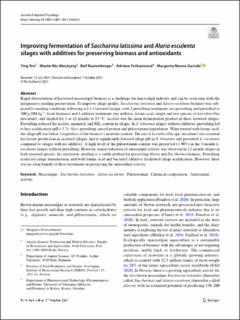| dc.contributor.author | Yen, Ying | |
| dc.contributor.author | Weisbjerg, Martin Riis | |
| dc.contributor.author | Rautenberger, Ralf | |
| dc.contributor.author | Fečkaninová, Adriána | |
| dc.contributor.author | Novoa-Garrido, Margarita | |
| dc.date.accessioned | 2022-02-28T13:16:47Z | |
| dc.date.available | 2022-02-28T13:16:47Z | |
| dc.date.created | 2021-10-28T09:34:13Z | |
| dc.date.issued | 2021 | |
| dc.identifier.citation | Yen, Y., Weisbjerg, M. R., Rautenberger, R., Fečkaninová, A. & Novoa-Garrido, M. (2021). Improving fermentation of Saccharina latissima and Alaria esculenta silages with additives for preserving biomass and antioxidants. Journal of Applied Phycology, 34(1). doi: | en_US |
| dc.identifier.issn | 1573-5176 | |
| dc.identifier.uri | https://hdl.handle.net/11250/2981740 | |
| dc.description.abstract | Rapid deterioration of harvested macroalgal biomass is a challenge for macroalgal industry and can be overcome with the inexpensive ensiling preservation. To improve silage quality, Saccharina latissima and Alaria esculenta biomass was subjected to ensiling conditions following a 2 × 4 factorial design, with 2 prewilting treatments (no-prewilting and prewilted to 300 g DM kg−1 fresh biomass) and 4 additive treatments (no additive, formic acid, single and two species of Lactobacillus inoculant), and ensiled for 3 or 12 months at 15 °C. Acetate was the main fermentation product in these seaweed silages. Prewilting reduced the acetate, mannitol, and NH3 content in silages. In S. latissima silages without additives, prewilting led to less acidification (pH = 5.7). Also, prewilting caused protein and phlorotannin degradation. When treated with formic acid, the silage pH was below 4 regardless of the biomass’s moisture content. The use of Lactobacillus spp. inoculants was essential for lactate production in seaweed silages, and it significantly lowered silage pH in S. latissima and prewilted A. esculenta compared to silages with no additives. A high level of the phlorotannin content was preserved (> 90%) in the 3-month A. esculenta silages without prewilting. However, major reduction of antioxidant activity was observed in 12-month silages in both seaweed species. In conclusion, ensiling is a viable method for preserving Alaria and Saccharina biomass. Prewilting restricted silage fermentation, and both formic acid and bacterial additives facilitated silage acidification. However, there was no clear benefit of these treatments in preserving the antioxidant activity. | en_US |
| dc.language.iso | eng | en_US |
| dc.publisher | Springer | en_US |
| dc.rights | Navngivelse 4.0 Internasjonal | * |
| dc.rights.uri | http://creativecommons.org/licenses/by/4.0/deed.no | * |
| dc.title | Improving fermentation of Saccharina latissima and Alaria esculenta silages with additives for preserving biomass and antioxidants | en_US |
| dc.type | Peer reviewed | en_US |
| dc.type | Journal article | en_US |
| dc.description.version | publishedVersion | en_US |
| dc.rights.holder | © 2021 The Author(s) | en_US |
| dc.subject.nsi | VDP::Landbruks- og fiskerifag: 900 | en_US |
| dc.source.volume | 34 | en_US |
| dc.source.journal | Journal of Applied Phycology | en_US |
| dc.source.issue | 1 | en_US |
| dc.identifier.doi | 10.1007/s10811-021-02628-4 | |
| dc.identifier.cristin | 1949143 | |
| dc.relation.project | MABIT: AF0083 | en_US |

